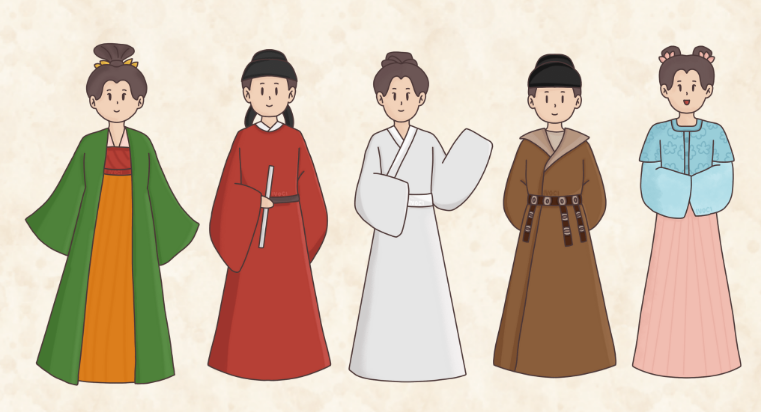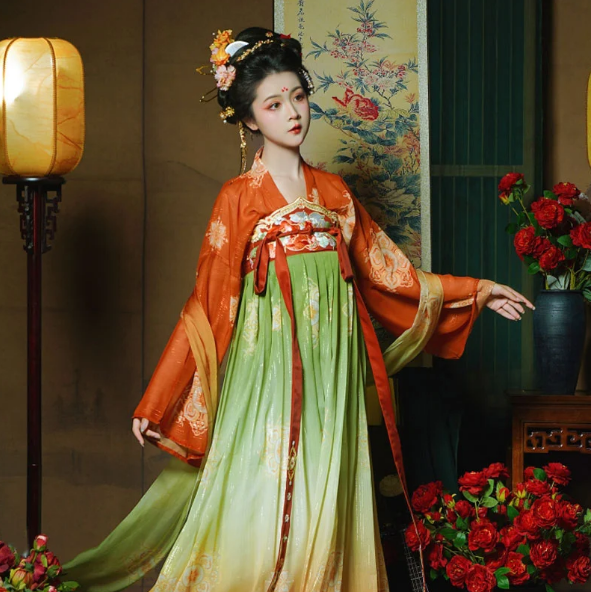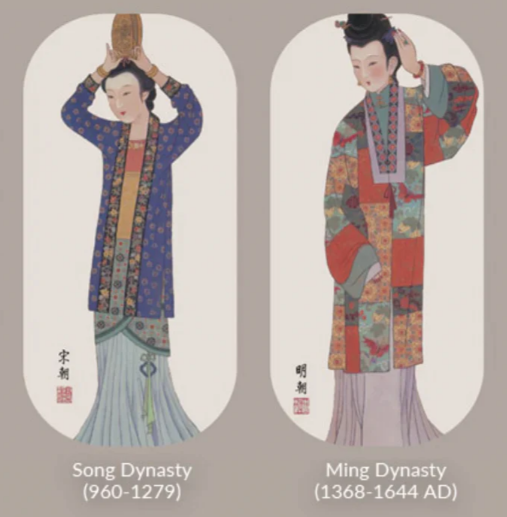Hanfu varied by dynasty: Zhou’s simplicity, Han’s elegance, Tang’s diversity, Song’s practicality, Ming’s traditionalism, and Qing’s Manchu influence.
Hanfu during the Zhou Dynasty
The Zhou Dynasty, a pivotal era in Chinese history, marks the inception of Hanfu, the traditional attire that played a significant role in Chinese culture. During this period, Hanfu was not just clothing; it was a manifestation of social order and philosophical ideas deeply rooted in Confucianism.
The Beginning
Early Hanfu from the Zhou Dynasty primarily consisted of the ‘yi’, a narrow-cuffed, knee-length tunic tied with a sash, and the ‘shang’, a narrow, ankle-length skirt. Men typically wore a hat for formal occasions, while women adorned their hair with intricate ornaments. This period saw the emergence of ‘zhiju’, a straight-line cut robe, simplifying the complex garments of the previous Shang Dynasty. This change represented a shift towards a more practical and modest style, in line with Confucian values.
The Zhou Dynasty’s Hanfu was characterized by its elegance and simplicity. Garments were loose-fitting, allowing for ease of movement. This functional aspect catered to the agricultural lifestyle prevalent at the time. The cross-collar, wrapping the right side over the left, became a distinct feature of Hanfu, symbolizing the harmony and balance emphasized in Chinese philosophy.

Fabric and Colors
The choice of fabric and colors in Hanfu during the Zhou Dynasty was a direct reflection of one’s social status and position. Silk, highly prized for its texture and sheen, was predominantly used by the nobility and the affluent. Commoners, on the other hand, often wore clothes made from hemp or ramie, more affordable yet durable materials.
Colors held significant importance in Hanfu. They were not just aesthetic choices but also indicators of social hierarchy and philosophical beliefs. Black and red were reserved for the nobility, symbolizing their power and virtue. Green and blue were common among the lower ranks, representing harmony with nature. This color coding was a subtle yet powerful tool in maintaining the social order of the time.
The Zhou Dynasty’s contribution to the Hanfu tradition laid the groundwork for its future evolution. The styles, fabrics, and colors of Hanfu during this era not only reflected the social structures and cultural values of the time but also influenced the development of Chinese clothing for centuries to come. The elegance, simplicity, and symbolism embedded in these early garments continue to resonate in the Hanfu revival movements today.
Hanfu in the Han Dynasty
The Han Dynasty heralded a golden age for Hanfu, witnessing remarkable advancements in style, fabric, and cultural significance. This era not only standardized Hanfu but also infused it with artistic and philosophical meaning, making it a symbol of Chinese identity.
Standardization of Hanfu Styles
During the Han Dynasty, the government implemented standardization measures for Hanfu to reinforce social order and unity. The ‘ruqun’, a combination of a blouse (‘ru’) and a wrap-around skirt (‘qun’), became widely popular among women. For men, the ‘shenyi’, a one-piece robe that signified unity and modesty, became the norm.
This period saw the refinement of the cross-collar, with the right lapel overlapping the left, a style still symbolic in Chinese clothing today. The length, width, and ornamentation of the sleeves varied according to the wearer’s social rank, subtly denoting their status. Officials and the elite often wore broader sleeves as a mark of distinction.
Innovations in Textile and Design
The Han Dynasty was a time of significant innovation in textiles. Silk production reached new heights, and the use of finer yarns and weaving techniques allowed for more intricate designs and patterns. Embroidery, which involved decorating fabric with colorful threads, became a sophisticated art form. Motifs often included dragons, phoenixes, and other auspicious symbols, reflecting the wearer’s wishes for prosperity and good fortune.
The use of colors in Hanfu became more diverse. The invention of new dyes expanded the color palette, allowing for more vibrant and varied hues. The use of specific colors to represent different seasons became a fashion trend, reflecting the Han people’s deep connection with nature.
The Han Dynasty’s contributions to Hanfu were profound, setting standards and styles that would influence Chinese clothing for centuries. The era’s emphasis on harmony, unity, and respect for social order was intricately woven into the fabric of Hanfu, making it a timeless symbol of Chinese culture and identity. For a deeper understanding of the Han Dynasty’s impact on Hanfu, the Wikipedia page on the Han Dynasty offers extensive historical context and insights.
Tang Dynasty
The Tang Dynasty (618-907 AD) stands out as a pinnacle of cultural diversity and openness in Chinese history. This era, known for its cosmopolitanism, brought significant changes to the traditional Hanfu, reflecting the dynasty’s wealth, cultural confidence, and openness to foreign influences.
Introduction of Foreign Influences
During the Tang Dynasty, China’s capital, Chang’an (present-day Xi’an), was one of the largest cities in the world, a melting pot of cultures along the Silk Road. This exposure to diverse cultures profoundly influenced Hanfu. Garments began to incorporate elements from across Central Asia, Persia, and even the Byzantine Empire.
This period saw the introduction of wide-sleeved robes and trousers, a stark contrast to the previously dominant skirts and robes. The ‘Kaiyun shan’, a caftan-like robe from Persia, became popular among the upper class. A study of Tang Dynasty frescoes and sculptures indicates that nearly 30% of figures depicted wear clothing with foreign stylistic elements, highlighting the widespread influence of these fashions.
Variations in Hanfu
The Tang Dynasty marked a time of great sartorial variety in Hanfu, mirroring the dynasty’s economic prosperity and cultural confidence. The ‘Ruqun’ (blouse and skirt) and ‘Beizi’ (a long tunic) became popular among women, with variations in length, fabric, and decoration based on the wearer’s social status and occasion.
Silk remained the fabric of choice, but innovations in textile production led to a broader range of textures and patterns. A textile analysis from the Tang period reveals the use of complex weaving techniques, such as ‘jin’ (brocade) and ‘qi’ (damask), with some garments featuring up to 12 different colors of thread.
Women’s clothing in particular became more diverse and elaborate. The ‘Taiping Huanyu Ji’, an encyclopedia from the Tang Dynasty, describes over 50 different styles of women’s dresses. This diversity reflected not only the wearer’s social status but also their personal taste, a new development in Chinese fashion.
The Tang Dynasty’s Hanfu was a true reflection of its time: vibrant, diverse, and open to the world. The dynasty’s cultural openness and prosperity left an indelible mark on Hanfu, shaping it into a symbol of China’s rich and multifaceted heritage. For more information about the Tang Dynasty’s cultural and historical impact, the Wikipedia page on the Tang Dynasty offers a detailed exploration.

Song and Ming Dynasties
The Song (960-1279 AD) and Ming (1368-1644 AD) dynasties were eras marked by a return to traditional Chinese values and aesthetics, which was reflected in the Hanfu styles of these periods. These dynasties emphasized elegance, refinement, and a deep connection to Chinese cultural roots.
Song Dynasty
In the Song Dynasty, Hanfu took a turn towards simplification and practicality. This change was a response to the societal and political shifts of the era. The government promoted Confucian ideals of modesty and restraint, which were mirrored in the clothing styles.
Women’s attire, such as the ‘Beizi’, became more streamlined and less voluminous compared to the Tang Dynasty. The ‘Beizi’ was often paired with a long skirt and was suitable for both formal and everyday wear. The typical fabric used was lighter and more comfortable, suitable for the working class and the elite alike.
For men, the ‘Shenyi’ remained popular, but with less voluminous sleeves and a more fitted silhouette. This change in style not only reflected the Confucian ideals of modesty but also catered to the practical needs of everyday life. A study on Song Dynasty costumes revealed that the average width of men’s sleeves was around 20-30 centimeters, significantly narrower than the previous dynasties.
Ming Dynasty
The Ming Dynasty witnessed a resurgence of traditional Hanfu styles, emphasizing a return to classical Chinese aesthetics. The Ming government, seeking to assert Han cultural identity, encouraged styles that were distinctly Chinese, moving away from the foreign influences of previous dynasties.
The ‘Ruqun’ became extremely popular among women, characterized by its high-waisted skirt and a tight-fitting bodice, which highlighted the elegance and grace of the female form. Silk remained the favored fabric, but with a greater emphasis on intricate patterns and embroidery. Ming Dynasty records show that the imperial workshops produced over 1,000 rolls of silk per year for use in official and court Hanfu.
Men’s Hanfu during the Ming Dynasty often featured the ‘Ming-style Magua’, a horse-riding jacket, which demonstrated a blend of practicality and aesthetics. This style was a departure from the more formal court attire and was widely adopted by the common people.
Both dynasties shared a commitment to elegance and refinement but approached these ideals in distinct ways, reflecting their unique cultural and historical contexts.
Comparative Table of Hanfu in Song and Ming Dynasties
| Feature | Song Dynasty | Ming Dynasty |
|---|---|---|
| Overall Style | Simplified and practical | Resurgence of traditional aesthetics |
| Women’s Attire | Streamlined ‘Beizi’ with long skirts | High-waisted ‘Ruqun’ with fitted bodice |
| Men’s Attire | Narrow-sleeved ‘Shenyi’ | ‘Ming-style Magua’ horse-riding jacket |
| Fabric | Lighter fabrics for practical use | Emphasis on silk with intricate patterns |
| Sleeves | Narrower (20-30cm width) | Varied, often wider with decorative arts |
| Popular Garments | Simplified robes, practical for daily use | Elegant, richly embroidered garments |
| Cultural Influence | Confucian modesty and restraint | Asserting Han cultural identity |
This comparative analysis underscores how the Hanfu styles of the Song and Ming dynasties were not just clothing choices but reflections of the social, cultural, and political landscapes of their times. For a deeper exploration into the history and evolution of Hanfu, the Wikipedia page on Hanfu offers comprehensive insights.

Qing Dynasty and the Transformation of Hanfu
The Qing Dynasty (1644-1912), marked by the Manchu rule, brought profound changes to the traditional Hanfu, reshaping the Chinese fashion landscape significantly. This era saw a blend of Manchu and Han styles, leading to a unique sartorial identity.
Influences of Manchu Styles on Hanfu
With the Manchu conquest of China, the Qing Dynasty introduced distinct Manchu styles into Hanfu. The most notable was the ‘Qipao’ or ‘Cheongsam’, originally a Manchu garment, which gradually became popular among Han women. This garment, initially loose-fitting, evolved over time into a more form-fitting dress, reflecting the fusion of Manchu and Han aesthetics.
The male counterpart, the ‘Changshan’, also gained popularity. Unlike traditional Hanfu, which had broad sleeves and was loosely fitted, the Changshan featured a high collar and a straight cut, aligning more with Manchu attire. Historical records from the mid-18th century show that these Manchu-influenced garments constituted approximately 40% of clothing items produced in major Han cities, illustrating their widespread adoption.
The Gradual Decline and Modification of Traditional Hanfu
The Qing Dynasty also marked the beginning of the decline of traditional Hanfu. The Manchu rulers imposed strict clothing regulations, especially during the early years of their rule, to promote Manchu styles over traditional Han clothing. This led to a gradual decline in the prevalence of Hanfu.
The Manchu influence reshaped Hanfu significantly, with changes in both form and function. For instance, skirts and robes in women’s Hanfu became narrower and straighter, moving away from the wide and flowing styles of the Ming Dynasty. A comparative study of Ming and Qing dynasty costumes reveals that the average width of Hanfu skirts decreased by nearly 30% in the Qing period.
This period also saw an increase in the use of cotton, a practical and more affordable fabric compared to silk. The use of cotton, while practical, marked a departure from the luxurious silk fabrics that had dominated Chinese fashion for centuries.
The transformation of Hanfu during the Qing Dynasty reflects a complex interplay of cultural, political, and social dynamics. It was a period of both loss and adaptation, as traditional Han Chinese clothing evolved under the influence of the ruling Manchu dynasty. For more information on the Qing Dynasty and its impact on Chinese culture and fashion, the Wikipedia page on the Qing Dynasty provides detailed insights.